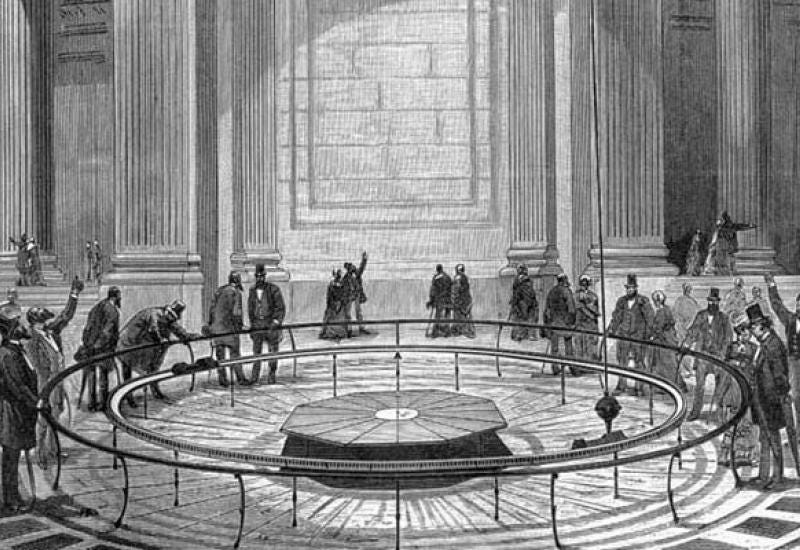Sunday, March 10, 2024
Heliocentricity and Theoretical Proofs (part four). The Foucault Pendulum
Proves nothing about the Earth's rotation or Heliocentricity.
by StFerdIII
(The former medical student Foucault, at the Pantheon in Paris in 1851, with his 200 foot bobbing block)
Prologue
The standard textbook list of ‘proofs’ for heliocentricity usually include this list:
1. Newton’s theory of gravitational attraction (this is false, previous post deals with this)
2. The Stellar Parallax (ibid)
3. Stellar aberration of the Sun (ibid)
4. The Foucault Pendulum (this post)
5. The bulge at the Equator
6. Geosynchronous satellites
7. Space probe measurements
8. Retrograde motion
9. Star-streaming
10. The Doppler effect
11. Geometric complexity of geocentrism
This post will look at the mighty Foucault pendulum. Across the world, there are probably thousands of shrines in secular buildings and desacralized churches, which show a replica of Foucault’s apparatus. Museums, the UN, laboratories, university labs, and former churches offer a chapel to the ‘great man’ Foucault and his machine, which in the mid-19th century, ‘proved’ heliocentricity and made a mockery of those geocentric religious ignoramuses and their mystical dogma. A fine story which sadly does not stand up to scrutiny.
Foucault the college drop out
Foucault was a mid-19th century French Catholic medical school dropout and part-time photographer. He has been historically repositioned as a ‘physics researcher’. Maybe ‘opportunist’ is a better career description.
At the ripe age of 32 he performed a public experiment which delighted the Sun-worshippers. In 1851 he suspended a 61-pound ball from a 200 foot wire at the pantheon in Paris and set it swinging. He drew a line in the sand below the apparatus and predicated that the pendulum would move 11.25 degrees in 60 minutes, which it did. Applause all around. This apparently proved the Earth’s motion. So, we are told.
The logic is the following:
1. Foucault’s first and primary assumption is that the Earth rotates itself once per 24 hours, moving west to east
2. In one day based on this assumption, the pendulum should swing between 0, or not moving (which would be equivalent to the equator) and 360 degrees (the poles), meaning that at the poles the pendulum should rotate the full 360 degrees
3. If we draw lines in the sand for this swinging pendulum, n would be the intersection angle between the first line witnessed after the swinging begins, and a line drawn 24 hours later (in reality the specific day time is 23 hours, 56 minutes and 4.1 seconds– this is a sidereal day or star time, slightly different than the solar time of 24 hours)
4. Another assumption is that there is no relative motion. This means that if we swing the pendulum north to south it won’t affect the plane it moves in, this is due to the underlying assumption that the Earth rotates west to east and cannot ‘twist’ itself underneath the pendulum
5. Foucault’s equation predicts the Earth’s movement based on the object’s latitude, with n=360°sin(θ), where θ is the latitude
What does it all mean?
Long before Galileo, medieval naturalists and scientists had studied the pendulum and time keeping. Mechanical clocks were first built in the 14th century and were complex instruments. In these clocks the pendulum is anchored in one plane, it does not move, it is stationary. Foucault’s contraption allowed the anchor to rotate, which allowed the pendulum to move and rotate over a given time.
Using Foucault’s apparatus, we could start swinging it between the 12 and 6 o’clock position, rotate the anchor and within one hour the pendulum should move to swing between the 1 and 7 o'clock position. Over 12 hours and 24 hours, the pendulum should again be swinging back at the 12 o’clock to 6 o’clock position.
To be fair, if you have tried a Foucault pendulum replica, they often don’t work (personal experience), but let’s assume it can work.
What ‘convinced’ the heliocentrists was the rather obvious fact that at different latitudes, there should be different effects on the pendulum. At the North Pole or 90 degrees, the plane of the pendulum will rotate a full 360 degrees each 24-hours, or about 15 degrees per hour. As one moves farther from the North Pole in a southerly direction, the pendulum will slow down its rotation.
In Paris, Foucault found that the plane of the pendulum rotated 11.25 degrees in the first hour – just as he predicted. At the equator there would be no movement of the pendulum, given it is at ‘0 degrees’. Below the equator the rotation begins anew but in the opposite direction to that observed in the northern hemisphere. There are many models to explain these observations, by themselves they don’t prove anything.



